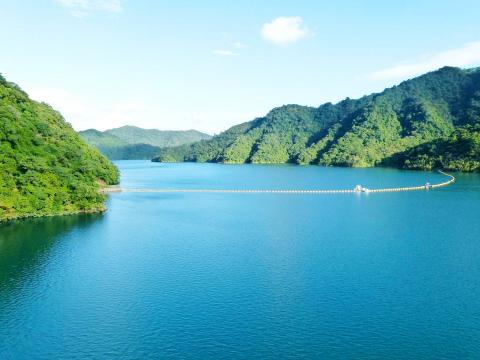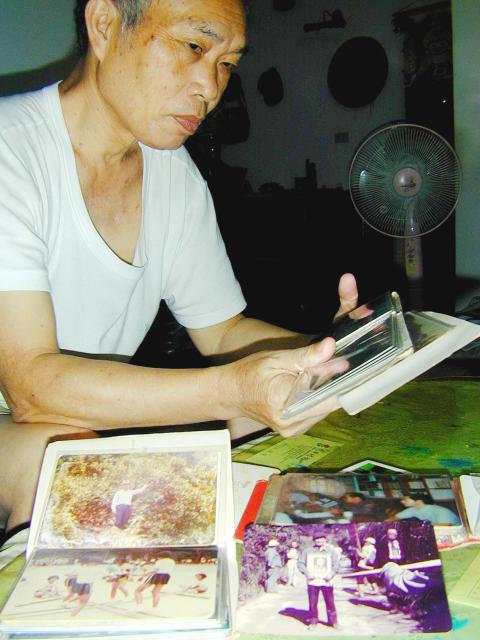June 26 to July 2
The ferry sets off into the Feitsui Reservoir every Tomb-Sweeping Day, taking passengers into restricted waters. Provided for free by reservoir authorities, this year it made 24 trips, taking 342 passengers to two locations.
These former residents of the area are only allowed to return once per year, and the grass has grown high. They disembark with bags of ancestral offerings and navigate the vegetation to find the graves of their ancestors. Some are underwater, and those residents place their offerings by the shore and pray toward the reservoir.

Photo courtesy of Taipei Feitsui Reservoir Administration
Graves are not the only structures that rest at the bottom of the reservoir. There are houses, temples and even an entirely submerged elementary school building that once serviced the children of Bishan Village (碧山). Shihding Township’s (石碇) official Web site indicates that the building resurfaced during a drought in 2002, comparing it to the sunken city of Atlantis.
THE DISPLACED
Located in New Taipei City and encompassing 303 square kilometers, the reservoir was completed on June 30, 1987 after eight years of construction. As the second-largest reservoir in Taiwan, people were inevitably displaced — although not to the degree caused by the Shihmen Dam (石門水庫) in the 1960s. Planning for the Feitsui Reservoir started in the early 1970s as the Taipei metropolitan area was suffering from overpumping of underground water, leading to water shortages and land subsidence in several areas.

Photo: Wang Chia-chun, Taipei Times
According to a Liberty Times (Taipei Times’ sister newspaper) report, Bishan was once the largest village in the area with more than 1,000 inhabitants. The residents had lived there for four generations, growing oranges and tea. Wang Chao-nan (王昭男) told the reporter that it was saddening to see that what once was a mountain next to his village had become an island, dubbed “Crocodile Island” for its shape, and is now a popular photo-op along the Beiyi Highway (北宜公路).
While most residents were removed, there were about 400 inhabitants who remained in the reservoir area living above the 171-meter flood line. These are mostly the ones who still make the yearly trip to worship their ancestors.
Although their villages survived, their lives were still greatly affected as the only bridge to the outside world went underwater. For years, they could only use government-provided ferries to go to work or school. The reservoir’s official Web site indicates that they were all relocated between 1995 and 2000.
Another victim of the reservoir was the Wulai azalea flower, which actually did not grow in Wulai but is native to an area now at the bottom of the reservoir. According to a 25th anniversary publication of Feitsui, the flower became a “rare and endangered plant” after the initial flooding in 1984. It has since been revived, and by 2012, authorities had planted about 10,000 saplings along the reservoir and its administrative offices.
UNWILLING RELOCATION
In 2002, the Liberty Times featured the last village head of Bishan, Chan Lung-kui (詹矓桂) on the 20th anniversary of his relocation to today’s Sindian District (新店). He wistfully displayed old photos of himself growing oranges and yearned for his lost homeland, stating that he was “forced” to leave.
While the aforementioned 25th anniversary publication only spares one sentence to the displaced (while dedicating a whole chapter to the revival of the azalea), it does state that residents were forced to leave.
While it’s easy to believe that the residents simply took their compensation and left, the relocations definitely did not take place that smoothly.
According to A Study on the Compensation Issue for Restricted Areas (限制發展地區土地利用受限補償課題之研究) by Ferng Jiun-jiun (馮君君) and Cho Chia-hui (卓佳慧), local residents attempted to stop the construction between Feb. 1 and Feb. 3 in 1982, and again from April 28 to May 1. They also attempted to protest at the dedication ceremony in 1987 but the police stopped them. The study also indicates that the government did not assist the remaining 400 or so villagers to relocate until they staged a demonstration by blocking the front gate to the reservoir in 1993. Another protest took place in 1994 regarding compensation.
Eventually, households with three people or fewer received $1.5 million, while those with four and above received NT$2 million, write Ferng and Cho.
Today, the reservoir continues to be an indispensable water source to northern Taiwan, and while access is restricted, tourists flock to the adjacent areas for some stunning views of the submerged mountains.
Meanwhile, the displaced villagers can only wait for Tomb Sweeping Day, so they can step on their old land once again.
Taiwan in Time, a column about Taiwan’s history that is published every Sunday, spotlights important or interesting events around the nation that have anniversaries this week.

On April 26, The Lancet published a letter from two doctors at Taichung-based China Medical University Hospital (CMUH) warning that “Taiwan’s Health Care System is on the Brink of Collapse.” The authors said that “Years of policy inaction and mismanagement of resources have led to the National Health Insurance system operating under unsustainable conditions.” The pushback was immediate. Errors in the paper were quickly identified and publicized, to discredit the authors (the hospital apologized). CNA reported that CMUH said the letter described Taiwan in 2021 as having 62 nurses per 10,000 people, when the correct number was 78 nurses per 10,000

As we live longer, our risk of cognitive impairment is increasing. How can we delay the onset of symptoms? Do we have to give up every indulgence or can small changes make a difference? We asked neurologists for tips on how to keep our brains healthy for life. TAKE CARE OF YOUR HEALTH “All of the sensible things that apply to bodily health apply to brain health,” says Suzanne O’Sullivan, a consultant in neurology at the National Hospital for Neurology and Neurosurgery in London, and the author of The Age of Diagnosis. “When you’re 20, you can get away with absolute

May 5 to May 11 What started out as friction between Taiwanese students at Taichung First High School and a Japanese head cook escalated dramatically over the first two weeks of May 1927. It began on April 30 when the cook’s wife knew that lotus starch used in that night’s dinner had rat feces in it, but failed to inform staff until the meal was already prepared. The students believed that her silence was intentional, and filed a complaint. The school’s Japanese administrators sided with the cook’s family, dismissing the students as troublemakers and clamping down on their freedoms — with

As Donald Trump’s executive order in March led to the shuttering of Voice of America (VOA) — the global broadcaster whose roots date back to the fight against Nazi propaganda — he quickly attracted support from figures not used to aligning themselves with any US administration. Trump had ordered the US Agency for Global Media, the federal agency that funds VOA and other groups promoting independent journalism overseas, to be “eliminated to the maximum extent consistent with applicable law.” The decision suddenly halted programming in 49 languages to more than 425 million people. In Moscow, Margarita Simonyan, the hardline editor-in-chief of the